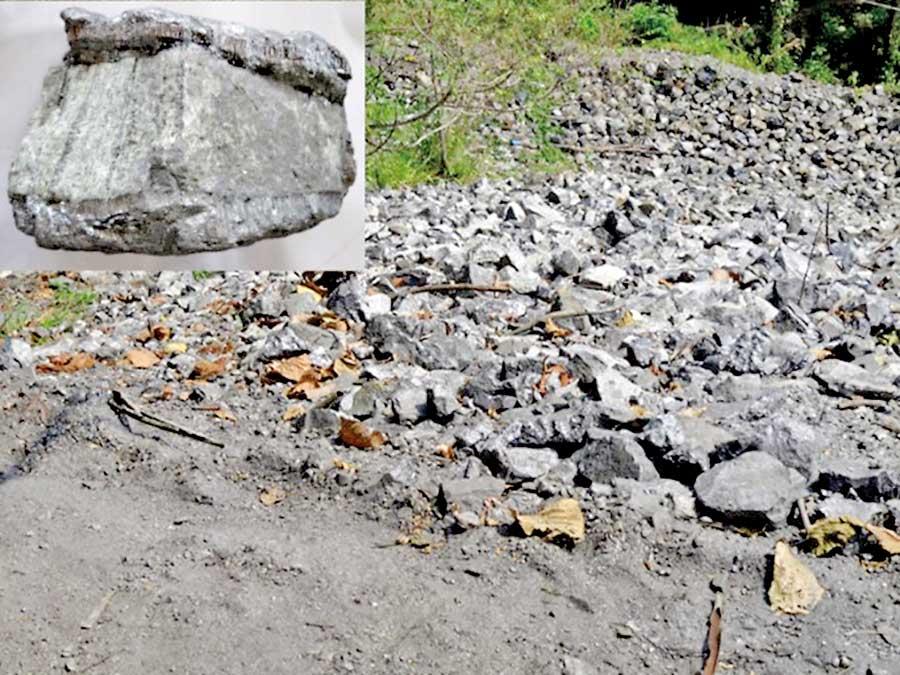Reply To:
Name - Reply Comment

Oil spills like the X-Press Pearl disaster can be cleaned up using expanded-graphite which is produced from discarded graphite-bearing quartz rock granules found in abundance in graphite mines in Sri Lanka
Oil spills from cargo ships transporting crude oil continue to pollute our oceans, severely endangering marine life and harming coastlines. In many cases the entire load of crude oil in vessels has spilled into the sea. Often in these mishaps the ships’ fuel tanks break open and tons of oil spill into the sea, causing widespread environmental hazard.
and harming coastlines. In many cases the entire load of crude oil in vessels has spilled into the sea. Often in these mishaps the ships’ fuel tanks break open and tons of oil spill into the sea, causing widespread environmental hazard.
As a rule, spilled oil spreads in thin layers approximately 0.01mm thick. This in turn can result in one kiloton (equal to 1000 tons) of oil spreading over ocean area of approximately 125 square km. The magnitude of the danger becomes clear when considering that oil tankers customarily carry over 100 kilotons of oil. More than 12 million barrels of oil have spilled into our oceans in the past two decades alone. The expanse of an oil spread caused by even a minor sea mishap is so immense that reversing its hazardous effects is an increasingly cumbersome and costly exercise.
Danger to marine life
It must be stressed that oil pollutants engender all forms of marine life, i.e. those inhabiting the vicinity of the surface, life in the deep sea or animals and plants on the coastline. For example, when aquatic animals like turtles dive up to the water surface to take a breath of oxygen, their respiratory organs dysfunction as the result of clogged oil, killing them within hours. Some animals die when they ingest oil.
"More than 12 million barrels of oil have spilled into our oceans in the past two decades alone. The expanse of an oil spread caused by even a minor sea mishap is so immense that reversing its hazardous effects is an increasingly cumbersome and costly exercise"
Furthermore, oil blocks sunlight from reaching deeper water below, greatly diminishing the process of photosynthesis in the affected region of the ocean. This deprives the primary source of food to all life in the sea. Additionally, dead photosynthetic and other organisms tend to aggravate pollution. Coral reefs are also extremely sensitive to pollution. Oil contamination impedes their reproduction process, and animals inhabiting the reef are severely affected.
Moreover, oil that reaches the coastline poisons plant and animal life in this habitat, and also contaminates freshwater outlets. And as we know, oil polluted beaches are unhealthy and unpalatable for recreational activities.
X-Press Pearl disaster
The X-Press Pearl disaster has heightened Sri Lanka’s concern regarding oil leakages from sinking vessels, and prompted more research into how such pollution can be remedied.
Removing oil slicks spread over water is a challenging problem. As everyone knows, water and oil do not mix. If you pour one pint of water and one pint of coconut oil into a bottle, the less dense and immiscible coconut oil will float on top of the water. Oil can be separated from water using a siphon. But this method is not readily adoptable to removing oil spread over a large area, like the sea for instance. If you add half a teaspoonful of coconut oil to a bowl of water it disperses into a thin film. But it is far more challenging to extract oil diffused over water by mechanical methods, without dragging a substantial quantity of water along with it.
Expanded-graphite
An innovative method to remove oil films on water is to use a material that selectively absorbs oil - meaning something that extracts oil only. Research has shown that an ideal material that possesses this quality is a form of graphite, which chemists refer to as ‘expanded-graphite’. All you need to do is position the sorbent—in this case expanded-graphite - into a permeable bag and sweep the oil-contaminated water surface—in this case the sea. Expanded-graphite is an exceptional substance as it floats on water and does not sink. An added advantage is, as oil sorbent, expanded-graphite can be recycled. A large percentage of absorbed oil can be extracted by squeezing the product, and the rest can be extracted by ignition, as expanded-graphite does not burn during ignition. Through research I have found that ignition improves the sorption capacity of the material. Sorption is the chemical process by which one substance becomes attached to another.
Scientifically speaking, graphite is a package of ultrathin sheets, each constituted of one atom thick mesh of carbon atoms bonded to each other. This structure is popularly known as ‘graphene’. In expanded-graphite these sheets are loosened and pulled apart, leaving spaces between individual sheets. Expanded-graphite possesses a unique property of absorbing liquids, specifically water repellant liquids like vegetable and mineral oils. One kg of expanded graphite has the capacity to absorb around 80 litres of oil—a value very high compared to other sorbents.
Years ago, I suggested that discarded graphite bearing quartz rock granules, heaped in our graphite mines, can be used to produce expanded-graphite. This would be invaluable as oil sorbent and a raw material for the synthesis of graphene. A technique for converting graphite deposits on quartz granules into expanded-graphite has been developed and patented by the National Institute of Fundamental Studies, Kandy, with myself and my collaborators Prof. Gamini Rajapaksa, Department of Chemistry - University of Peradeniya, Prof. H.M.T.G.A. Pitawala, Director PGIS - University of Peradeniya and N. M. Gunawardana mentioned as inventors. Furthermore, graphene derived from expanded-graphite is a versatile material, widely investigated worldwide, for its potential uses in the areas of electronics and high-tech structural engineering.
Graphitic quartz rocks granules, which are thrown away in Sri Lankan mines, should ideally be used for profitable industrial applications. Expanded-graphite and graphene are marketable products that could be manufactured in Sri Lanka and effectively used for cleaning up oil spills. Graphite is a resource-limited mineral, and graphite impregnated rock granules heaped in our mines should not be allowed to go to waste.
The author is a Research Professor in Material Processing and Device Fabrication project at the National Institute of Fundamental Studies, Sri Lanka. His research focuses on low-cost dye-sensitized solid-state and liquid-phase solar cells.